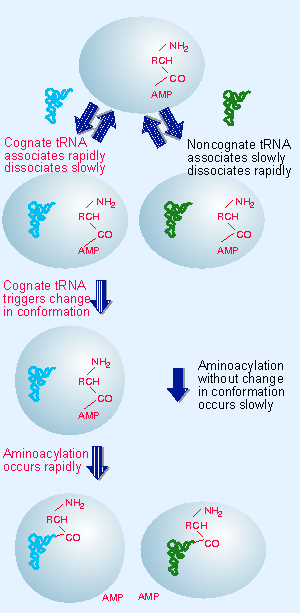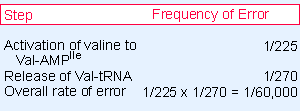6. Accuracy depends on proofreading
7.6 Accuracy depends on proofreading |
| Key terms defined in this section |
| Proofreading refers to any mechanism for correcting errors in protein or nucleic acid synthesis that involves scrutiny of individual units after they have been added to the chain. |
The nature of discriminatory events is a general issue raised by several steps in gene expression. How do synthetases recognize just the corresponding tRNAs and amino acids? How does a ribosome recognize only the tRNA corresponding to the codon in the A site? How do the enzymes that synthesize DNA or RNA recognize only the base complementary to the template? Each case poses a similar problem: how to distinguish one particular member from the entire set, all of which share the same general features.
Probably any member initially can contact the active center by a random-hit process, but then the wrong members are rejected and only the appropriate one is accepted. The appropriate member is always in a minority (1 of 20 amino acids, 1 of ~40 tRNAs, 1 of 4 bases), so the criteria for discrimination must be strict. We can imagine two general ways in which the decision whether to reject or accept might be taken:
- The cycle of admittance, scrutiny, rejection/acceptance could represent a single binding step that precedes all other stages of whatever reaction is involved. This is tantamount to saying that the affinity of the binding site is sufficient to control the entry of substrate. In the case of synthetases, this would mean that only the cognate tRNAs could form a stable attachment at the site.
- Alternatively, the reaction proceeds through some of its stages, after which a decision is reached on whether the correct species is present. If it is not present, the reaction is reversed, or a bypass route is taken, and the wrong member is expelled. This sort of postbinding scrutiny is generally described as proofreading. In the example of synthetases, it would require that the charging reaction proceeds through certain stages even if the wrong tRNA or amino acid is present.
Synthetases use proofreading mechanisms to control the recognition of both tRNA and amino acid.
 |
Figure 7.15 Recognition of the correct tRNA by synthetase is controlled at two steps. First, the enzyme has a greater affinity for its cognate tRNA. Second, the aminoacylation of the incorrect tRNA is very slow. |
Transfer RNA binds to synthetase by the two stage reaction depicted in Figure 7.15. Cognate tRNAs have a greater intrinsic affinity for the binding site, so they are bound more rapidly and dissociate more slowly. Following binding, the enzyme scrutinizes the tRNA that has been bound. If the correct tRNA is present, binding is stabilized by a conformational change in the enzyme. This allows aminoacylation to occur rapidly. If the wrong tRNA is present, the conformational change does not occur. As a result, the reaction proceeds much more slowly; this increases the chance that the tRNA will dissociate from the enzyme before it is charged. This type of control is called kinetic proofreading (450).
Specificity for amino acids varies among the synthetases. Some are highly specific for initially binding a single amino acid, but others can also activate amino acids closely related to the proper substrate. Although the analog amino acid can sometimes be converted to the adenylate form, in none of these cases is an incorrectly activated amino acid actually used to form a stable aminoacyl-tRNA.
The presence of the cognate tRNA usually is needed to trigger proofreading, even if the reaction occurs at the stage before formation of aminoacyl-adenylate. (An exception is provided by Met-tRNA synthetase, which can reject noncognate aminoacyl-adenylate complexes even in the absence of tRNA.)
 |
Figure 7.16 When a synthetase binds the incorrect amino acid, proofreading requires binding of the cognate tRNA. It may take place either by a conformation change that causes hydrolysis of the incorrect aminoacyl- adenylate, |
There are two stages at which proofreading of an incorrect aminoacyl-adenylate may occur during formation of aminoacyl-tRNA. Figure 7.16 shows that both use chemical proofreading, in which the catalytic reaction is reversed. The extent to which one pathway or the other predominates varies with the individual synthetase:
- The noncognate aminoacyl-adenylate may be hydrolyzed when the cognate tRNA binds. This mechanism is used predominantly by several synthetases, including those for methionine, isoleucine, and valine. (Usually, the reaction cannot be seen in vivo, but it can be followed for Met-tRNA synthetase when the incorrectly activated amino acid is homocysteine [which lacks the methyl group of methionine]. Proofreading releases the amino acid in an altered form, as homocysteine thiolactone. In fact, homocysteine thiolactone is produced in E. coli as a byproduct of the charging reaction of Met-tRNA synthetase. This shows that continuous proofreading is part of the process of charging a tRNA with its amino acid (451).
- Some synthetases use chemical proofreading at a later stage. The wrong amino acid is actually transferred to tRNA, is then recognized as incorrect by its structure in the tRNA binding site, and so is hydrolyzed and released. The process requires a continual cycle of linkage and hydrolysis until the correct amino acid is transferred to the tRNA.
 |
Figure 7.17 The accuracy of charging tRNAIle by its synthetase depends on error control at two stages. |
A classic example in which discrimination between amino acids depends on the presence of tRNA is provided by the Ile-tRNA synthetase of E. coli. The enzyme can charge valine with AMP, but hydrolyzes the valyl-adenylate when tRNAIle is added. The overall error rate depends on the specificities of the individual steps, as summarized in Figure 7.17. The overall error rate of 1.5 10 V5 is less than the measured rate at which valine is substituted for isoleucine (in rabbit globin), which is 2 V5 10 V4. So mischarging probably provides only a small fraction of the errors that actually occur in protein synthesis.
In the case of Ile-tRNA synthetase, accuracy is ensured by multiple mechanisms. The crystal structure of the enzyme shows that the activation site is too small to allow leucine (a close analog of isoleucine) to enter. Adjacent to the activation site is a second site, the hydrolytic site, which is too small to allow isoleucine itself to enter. However, valine can enter this site, and as a result an incorrect Val-tRNAIle is hydrolyzed. The activation and hydrolytic sites form a closed cavity within the enzyme. The combination of mechanisms provides a molecular sieve, in which size of the amino acid is important (452; for review see 40).
| Reviews | |
| 40: | Jakubowski, H. and Goldman, E. (1992). Editing of errors in selection of amino acids for protein synthesis. Microbiol. Rev. 56, 412-429. |
| Research | |
| 450: | Hopfield, J. J. (1974). Kinetic proofreading: a new mechanism for reducing errors in biosynthetic processes requiring high specificity. Proc. Nat. Acad. Sci. USA 71, 4135-4139. |
| 451: | Jakubowski, H. (1990). Proofreading in vivo: editing of homocysteine by methionyl-tRNA synthetase in E. coli. Proc. Nat. Acad. Sci. USA 87, 4504-4508. |
| 452: | Nureki, O. et al. (1998). Enzyme structure with two catalytic sites for double sieve selection of substrate. Science 280, 578-581. |